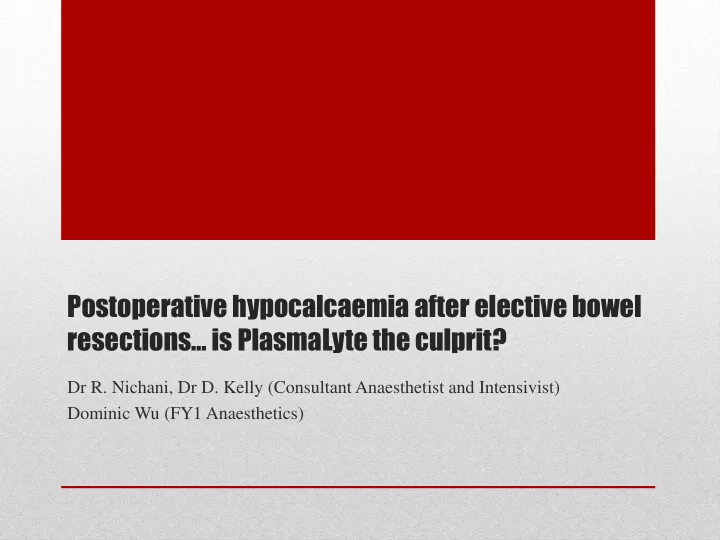

Postoperative hypocalcaemia after elective bowel resections… is PlasmaLyte the culprit? Dr R. Nichani, Dr D. Kelly (Consultant Anaesthetist and Intensivist) Dominic Wu (FY1 Anaesthetics)
• Balanced solutions are the replacement intravenous fluids of choice for patients undergoing major elective surgery • Our trust has replaced Hartmann’s with PlasmaLyte , a calcium-free crystalloid, in February 2012 • Critical care directorates have anecdotally noticed an increased incidence of “ biochemical hypocalcaemia ” in patients who are admitted to ICU/HDU • We hypothesized that the change of intravenous fluid has contributed to the low serum calcium level of patients on presentation to critical care Rationale
• Retrospective study • Approved by the Local Research and Ethics Committee as a Service Evaluation Project • Population of interest were patients who underwent elective major bowel resections between: • August’11 – January’12 (Group A: Hartmann’s) • August’12 – January’13 (Group B: Post-Plasmalyte) • August’13 – January’14 (Group C: Post-Plasmalyte) Methods
• Primary outcome • Hypocalcaemia (Defined as Adj. Ca < 2.20mmol/L) • Secondary outcomes • Changes in serum albumin, magnesium and creatinine Outcomes of Interest
• Data synthesis • Hospital Identifier, Gender and D.O.B. of patients who underwent major bowel resections in Theatre 11 and 12 were collected using ORMIS (Theatre Management) • Data extraction • Biochemical results inc. total calcium, albumin, adjusted calcium, magnesium and creatinine taken on the day of preoperative assessment and up to two days following the surgery were obtained via CyberLAB Data collection
• Paired Students’ T Test* • Difference of mean values within the same group • One-way ANOVA Test** • Difference of mean values between the three groups * P value < 0.001 as statistical significant **A large F ratio (between-group variability/ within- group variability) indicates high statistical significance of mean variables between the three study groups Statistical Analysis
Hartmann’s Demographics Plasmalyte 1 Plasmalyte 2 Number 75 81 69 Male:Female 47:28 44:37 25:44 Mean Age 64.8 65.8 67.3 Laparoscopic procedure 44 39 37 Open procedure 19 24 13 Not specified 12 18 19 Anterior Resection 29 27 25 AP Resection 7 7 5 Right hemicolectomy 24 28 19 Left hemicolectomy 5 3 6 Small bowel resection 4 4 3 Miscellaneous 6 12 11 Results
Hartmann’s Blood parameters Plasmalyte 1 Plasmalyte 2 (mean ± SD) Albumin (g/L) Pre-op 41.39 5.53 40.90 3.78 41.10 3.43 Day 0 30.72 5.26 29.44 5.37 31.83 3.89 29.87 4.14 30.36 4.78 31.10 4.15 Day 1 30.18 4.28 30.09 5.06 31.04 4.15 Day 2 Creatinine (mmol/L) 81.81 30.09 78.33 20.04 77.06 17.80 Pre-op 70.00 30.09 67.81 19.55 67.69 21.76 Day 0 Day 1 75.70 24.01 73.28 22.04 69.88 17.91 75.13 31.88 72.19 23.39 69.48 22.76 Day 2
Mean values of Adjusted Calcium 2.45 2.40 Adjusted Ca2+ (mmol/L) 2.35 2.30 Hartmann's Plasmalyte 1 2.25 Plasmalyte 2 2.20 2.15 2.10 Pre-op Day 0 Day 1 Day 2
Day 2 Adj Calcium Preop Adj Calcium Day 0 Adj Calcium Day 1 Adj Calcium p<000.1, F =17.37 p=0.33, F = 1.123 p <000.1, F = 35.81 p<000.1, F = 48.21 ANOVA
Levels of Magnesium (No Baseline) 1.00 0.95 0.90 0.85 Mg2+ (mmol/L) Hartmann's 0.80 Plasmalyte 1 Plasmalyte 2 0.75 0.70 0.65 0.60 Day 0 Day 1 Day 2 Miscellaneous
• Trials comparing crystalloids and colloids in major surgeries are all underpowered to determine clinical benefits and risks (Anesth Analg 2012;114:640 – 51) • The use of buffered fluids is associated with less metabolic derangement, in particular hyperchloraemia and metabolic acidosis (Cochrane Database Syst Rev. 2012;12:CD004089) • Observational studies of 31920 patients with plasmalyte as replacement fluid on the day of major open abdominal surgery was associated with less postoperative morbidity than 0.9% saline (Ann Surg. 2012; 255(5):821-9.) • No convincing evidence as to whether gluconate, acetate or lactate buffered solutions produces better postoperative outcomes following major abdominal surgery Discussion
• Effect of Different Crystalloid Solutions on Acid-Base Balance and Early Kidney Function After Kidney Transplantation Anesthesia & Analgesia. 107(1):264- 269, July 2008 • Plasma acetate, gluconate and interleukin-6 profiles during and after cardiopulmonary bypass: a comparison of Plasma-Lyte 148 with a bicarbonate- balanced solution. Crit Care. 2011;15(1):R21. • A balanced view of balanced solutions. Critical Care 2010, 14:325 • Impact of Plasma-Lyte pH 7.4 on acid-base status and hemodynamics in a model of controlled hemorrhagic shock. Clinics (Sao Paulo). 2011; 66(11): 1969 – 1974
• No study to date has compared postoperative calcium changes between different crystalloid solutions • Research question answered that the incidence of biochemical hypocalcaemia has significantly risen since the change of crystalloid in our trust
• Our work is limited as supportive information are lacking • Type and amount of peri-operative fluids used • Levels of ionized Ca • Clinical hypocalcaemia e.g. tetany, arrhythmia etc • Whether patient received massive transfusion • Whether Ca supplements had been given to patients Limitations
• Incidence of biochemical hypocalcaemia is significantly higher in surgical patients who received PlasmaLyte than Hartmann's following elective bowel resections Summary
Recommend
More recommend